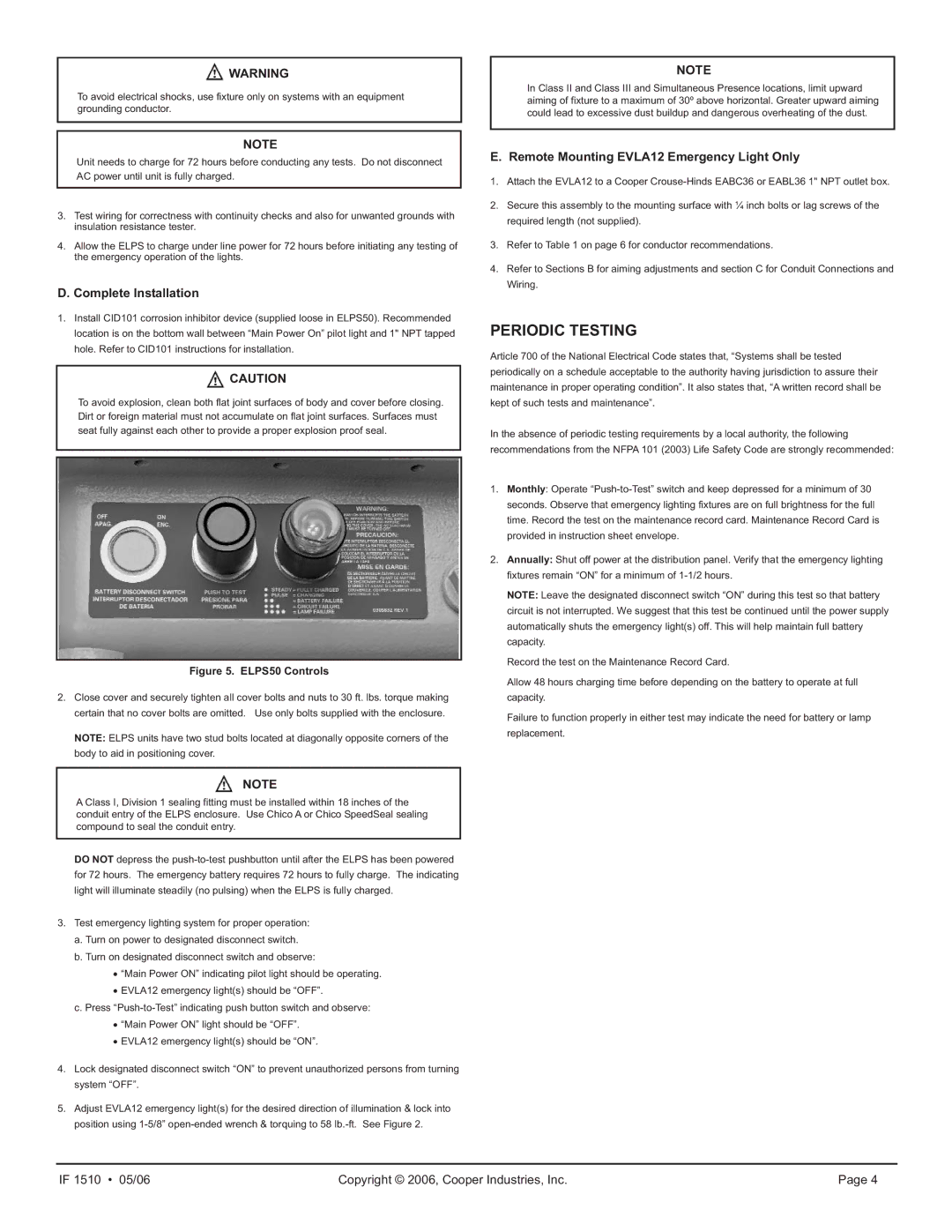
![]() WARNING
WARNING
To avoid electrical shocks, use fixture only on systems with an equipment grounding conductor.
NOTE
In Class II and Class III and Simultaneous Presence locations, limit upward aiming of fixture to a maximum of 30º above horizontal. Greater upward aiming could lead to excessive dust buildup and dangerous overheating of the dust.
NOTE
Unit needs to charge for 72 hours before conducting any tests. Do not disconnect AC power until unit is fully charged.
3.Test wiring for correctness with continuity checks and also for unwanted grounds with insulation resistance tester.
4.Allow the ELPS to charge under line power for 72 hours before initiating any testing of the emergency operation of the lights.
D. Complete Installation
1.Install CID101 corrosion inhibitor device (supplied loose in ELPS50). Recommended location is on the bottom wall between “Main Power On” pilot light and 1" NPT tapped hole. Refer to CID101 instructions for installation.
![]() CAUTION
CAUTION
To avoid explosion, clean both flat joint surfaces of body and cover before closing. Dirt or foreign material must not accumulate on flat joint surfaces. Surfaces must seat fully against each other to provide a proper explosion proof seal.
Figure 5. ELPS50 Controls
2.Close cover and securely tighten all cover bolts and nuts to 30 ft. lbs. torque making certain that no cover bolts are omitted. Use only bolts supplied with the enclosure.
NOTE: ELPS units have two stud bolts located at diagonally opposite corners of the body to aid in positioning cover.
NOTE
A Class I, Division 1 sealing fitting must be installed within 18 inches of the conduit entry of the ELPS enclosure. Use Chico A or Chico SpeedSeal sealing compound to seal the conduit entry.
DO NOT depress the
3.Test emergency lighting system for proper operation:
a.Turn on power to designated disconnect switch.
b.Turn on designated disconnect switch and observe:
•“Main Power ON” indicating pilot light should be operating.
•EVLA12 emergency light(s) should be “OFF”.
c.Press
•“Main Power ON” light should be “OFF”.
•EVLA12 emergency light(s) should be “ON”.
4.Lock designated disconnect switch “ON” to prevent unauthorized persons from turning system “OFF”.
5.Adjust EVLA12 emergency light(s) for the desired direction of illumination & lock into position using
E. Remote Mounting EVLA12 Emergency Light Only
1.Attach the EVLA12 to a Cooper
2.Secure this assembly to the mounting surface with ¼ inch bolts or lag screws of the required length (not supplied).
3.Refer to Table 1 on page 6 for conductor recommendations.
4.Refer to Sections B for aiming adjustments and section C for Conduit Connections and Wiring.
PERIODIC TESTING
Article 700 of the National Electrical Code states that, “Systems shall be tested periodically on a schedule acceptable to the authority having jurisdiction to assure their maintenance in proper operating condition”. It also states that, “A written record shall be kept of such tests and maintenance”.
In the absence of periodic testing requirements by a local authority, the following recommendations from the NFPA 101 (2003) Life Safety Code are strongly recommended:
1.Monthly: Operate
2.Annually: Shut off power at the distribution panel. Verify that the emergency lighting fixtures remain “ON” for a minimum of
NOTE: Leave the designated disconnect switch “ON” during this test so that battery circuit is not interrupted. We suggest that this test be continued until the power supply automatically shuts the emergency light(s) off. This will help maintain full battery capacity.
Record the test on the Maintenance Record Card.
Allow 48 hours charging time before depending on the battery to operate at full capacity.
Failure to function properly in either test may indicate the need for battery or lamp replacement.
IF 1510 • 05/06 | Copyright © 2006, Cooper Industries, Inc. | Page 4 |
